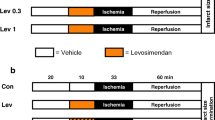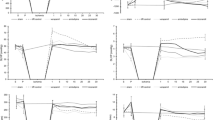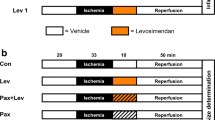Abstract
The ATP-sensitive K+ channel (KATP channel) has been implicated in the mechanism of ischemic preconditioning. We compared the protective effects of ischemic preconditioning and a highly selective KATP channel opener, BMS 180448, in human myocardium. BMS 180448 was either used alone or in combination with the KATP channel blocker glibenclamide. Human atrial trabeculae derived from the right atrial appendage were suspended in an organ bath, superfused with oxygenated Tyrode's solution at 37°C, and paced at 1 Hz. Experimental groups (n = 6 in each) were as follows: (1) control (C)—90 minutes hypoxic substrate-free perfusion at 3 Hz (simulated ischemia), followed by 120 minutes of reoxygenation with substrate at 1 Hz (reperfusion); (2) preconditioning (PC)—3 minutes simulated ischemia, 7 minutes reperfusion, followed by 90 minutes simulated ischemia and 120 minutes reperfusion; (3) BMS 180448 (BMS)—exposure to the drug for 5 minutes prior to 90 minutes simulated ischemia and 120 minutes reperfusion; (4) BMS 180448 + glibenclamide (BMS + G)—glibenclamide exposure for 10 minutes, and BMS for 5 minutes prior to 90 minutes simulated ischemia and 120 minutes reperfusion. Force of contraction prior to the commencement of the protocol was assigned the arbitrary value of 100%. Percentage recovery of contractile function at 120 minutes reperfusion was used as the endpoint. BMS (59.2 ± 8.6%) and preconditioning (50.5 ± 3.6%) produced a similar degree of recovery of function at the end of 120 minutes of reperfusion; this was significantly different from the untreated control group (20.8 ± 3.5%, p > 0.05, ANOVA). When glibenclamide was added prior to BMS, protection was lost (20.5 ± 2.7%). In this human atrial preparation, a highly selective KATP channel opener mimicked the protective effect of ischemic preconditioning. This protective effect of BMS was abolished by glibenclamide. These findings confirm that the mechanism of ischemic preconditioning in human muscle may be mediated via opening of the KATP channel.
Similar content being viewed by others
References
Murry CE, Jennings RB, Reimer KA. Preconditioning with ischaemia: A delay of lethal cell injury in ischaemic myocardium. Circulation 1986;74:1124–1136.
Downey JM, Liu GS, Thornton JD. Adenosine and the antiinfarct effects of preconditioning. Cardiovasc Res 1993;27:3–8.
Asimakis GK, Inners-McBride K, Medelin G, Conti VR. Ischaemic preconditioning attenuates acidosis and postischaemic dysfunction in isolated rat heart. Am J Physiol 1992;32:H887–H892.
Murry CE, Richard VJ, Reimer KA, Jennings RB. Ischaemic preconditioning slows energy metabolism and delays ultrastructural damage during a sustained ischaemic episode. Circ Res 1990;66:913–931.
Kida M, Yokota R, Tanaka M. Effect of ischaemic preconditioning on energy metabolism during short sustained ischaemia and reperfusion in pig hearts. J Moll Cell Cardiol 1992;24(Suppl II):IIS.5.
Cribier A, Korsatz L, Koning R, et al. Improved myocardial ischaemic response and enhanced collateral circulation with long repetitive coronary occlusion during angioplasty: A prospective study. J Am Coll Cardiol 1992;20:578–586.
Deutsch E, Berger M, Kussmaul W, Hirshfeld J, Herrmann H, Laskey W. Adaptation to ischaemia during percutaneous transluminal coronary angioplasty: Clinical, haemodynamic, and metabolic features. Circulation 1990;82:2044–2051.
Tomai F, Crea F, Gaspardone A, et al. Mechanisms of cardiac pain during coronary angioplasty. J Am Coll Cardiol 1993;22:1892–1896.
Ottani F, Galvani M, Ferrini D, et al. Prodromal angina limits infarct size: A role for ischaemic preconditioning. Circulation 1995;91:291–297.
Kloner R, Shook T, Przyklenk K, et al. Previous angina alters in-hospital outcome in TIMI 4: Clinical correlate to preconditioning? Circulation 1995;91:37–47.
Yellon DM, Alkhulaifi AM, Pugsley WB. Preconditioning the human myocardium. Lancet 1993;342:276–277.
Alkhulaifi A, Yellon D, Pugsley W. Preconditioning the human heart during aorto-coronary bypass surgery. Eur J Cardiothorac Surg 1994;8:270–276.
Walker D, Walker J, Pugsley W, Pattison C, Yellon D. Preconditioning in isolated superfused human muscle. J Moll Cell Cardiol 1995;27:1349–1357.
Speechly-Dick ME, Grover GJ, Yellon DM. Does ischaemic preconditioning in the human involve protein kinase C and the ATP-dependent K+ channel? Studies of contractile function following simulated ischaemia in an atrial in vitro model. Circ Res 1995;77:1030–1035.
Grover G, McCullough J, D'Alonzo A, Sargent C, Atwal K. Cardioprotective profile of the cardiac selective ATP-sensitive potassium channel opener BMS-180448. J Cardiovasc Pharmacol 1995;25:40–50.
Yellon D, Alkhulaifi A, Browne E, Pugsley W. Ischaemic preconditioning limits infarct size in the rat heart. Cardiovasc Res 1992;26:983–987.
Walsh R, Borges M, Thornton J, Cohen M. Hypoxia preceeding ischaemia reduces infarction despite the lack of an intervening period of reoxygenation (abstract). Circulation 1992;86(Suppl I):I 342.
Walker D, Walker J, Yellon D. Global myocardial ischaemia protects the myocardium from subsequent regional ischaemia. Cardioscience 1993;4:263–266.
Lasley R, Anderson G, Mentzer R. Ischaemic and hypoxic preconditioning enhance postischaemic recovery of function in the rat heart. Cardiovasc Res 1993;27:565–570.
Webster K, Discher D, Bishopric N. Cardioprotection in an in vitro model of hypoxic preconditioning. J Mol Cell Cardiol 1995;27:453–458.
Ovize M, Przyklenk K, Hale S, Kloner R. Preconditioning does not attenuate myocardial stunning. Circulation 1992;85:2247–2254.
Jenkins D, Pugsley W, Yellon D. Ischaemic preconditioning in a model of global ischaemia: Infarct size limitation, but no reduction of stunning. J Mol Cell Cardiol 1995;27:1623–1632.
Walker D, Marber M, Walker J, Yellon D. Preconditioning in isolated superfused rabbit papillary muscles. Am J Physiol 1994;266:H1534–H1540.
Gross GJ, Auchampach JA. Blockade of ATP-sensitive potassium channels prevents myocardial preconditioning in dogs. Circ Res 1992;70:223–233.
Auchampach J, Grover G, Gross G. Blockade of ischaemic preconditioning in dogs by the novel ATP-dependent potassium channel antagonist sodium 5-hydroxydecanoate. Cardiovasc Res 1992;26:1054–1062.
Schultz R, Rose J, Heusch G. Involvement of activation of ATP-dependent potassium channels in ischaemic preconditioning in swine. Am J Physiol 1994;267:H1341–H1352.
Liu Y, Downey JM. Ischaemic preconditioning protects against infarction in rat heart. Am J Physiol 1992;263:H1107–H1112.
Grover G, Dzwonczyk S, Sleph P, Sargent C. The ATP-sensitive potassium channel blocker glibenclamide (Glyburide) does not abolish preconditioning in isolated ischaemic rat hearts. J Pharmacol Exp Ther 1993;265:559–564.
Thornton J, Thornton C, Sterling D, Downey J. Blockade of ATP-sensitive potassium channels increases infarct size but does not prevent preconditioning in rabbit hearts. Circ Res 1993;72:44–49.
Toombs C, Moore T, Shebuski R. Limitation of infarct size in the rabbit by ischaemic preconditioning is reversible with glibenclamide. Cardiovasc Res 1993;27:617–622.
Grover G, D'Alonzo A, Hess T, Sleph P, Darbenzio R. Glyburide-reversible cardioprotective effect of BMS-180448 is independent of action potential shortening. Cardiovasc Res 1995;30:731–738.
Sakamoto S, Liang C, Stone C, Hood W. Effects of pinacidal on myocardial blood flow and infarct size after acute left anterior descending coronary artery occlusion and reperfusion in awake dogs with and without a coexisting left circumflex coronary artery stenosis. J Cardiovasc Pharmacol 1989;14:747–755.
D'Alonzo A, Grover G. Potassium channel openers are unlikely to be proarrhythmic in the diseased human heart. Cardiovasc Res 1994;28:924–925.
Cole W, McPherson C, Sontag D. ATP-regulated K+ channels protect the myocardium against ischaemia/reperfusion damage. Circ Res 1991;69:571–581.
Yao Z, Gross G. Effects of the KATP channel opener bimakalim on coronary blood flow, monophasic action potential duration, and infarct size in dogs. Circulation 1994;89:1769–1775.
Inoue I, Nagase H, Kishi K, Higuti T. ATP-sensitive K+ channel in mitochondrial inner membrane. Nature 1991;352:244–247.
Nayler W. Calcium, calcium antagonism, atherosclerosis, and ischaemia. J Cardiovasc Pharmacol 1992;19:S17–S21.
Behling R, Malone H. K-ATP channel openers protect against increased cytosolic calcium during ischaemia and reperfusion. J Mol Cell Cardiol 1995;27:1809–1817.
Wollmering M, Fullerton D, Walther J, Harken A, Banerjee A. Preconditioning protects function and viability in human ventricle. Circulation 1994;90:I477.
Heidbuchel H, Vereecke J, Carmeliet E. Three different potassium channels in human atrium: Contribution to the basal potassium conductance. Circ Res 1990;66:1277–1286.
Tomai F, Crea F, Gaspardone A, et al. Ischaemic preconditioning during coronary angioplasty is prevented by glibenclamide, a selective ATP-sensitive K+ channel blocker. Circulation 1994;90:7000–705.
Author information
Authors and Affiliations
Rights and permissions
About this article
Cite this article
Carr, C.S., Grover, G.J., Pugsley, W.B. et al. Comparison of the Protective Effects of a Highly Selective ATP-Sensitive Potassium Channel Opener and Ischemic Preconditioning in Isolated Human Atrial Muscle. Cardiovasc Drugs Ther 11, 473–478 (1997). https://doi.org/10.1023/A:1007753623597
Issue Date:
DOI: https://doi.org/10.1023/A:1007753623597




